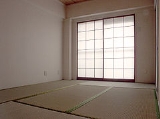
Washitsu
Encyclopedia


A distinguishing feature of washitsu (or nihonma) is their tatami
Tatami
A is a type of mat used as a flooring material in traditional Japanese-style rooms. Traditionally made of rice straw to form the core , with a covering of woven soft rush straw, tatami are made in standard sizes, with the length exactly twice the width...
flooring. Washitsu also usually have sliding doors (fusuma
Fusuma
In Japanese architecture, fusuma are vertical rectangular panels which can slide from side to side to redefine spaces within a room, or act as doors. They typically measure about wide by tall, the same size as a tatami mat, and are two or three centimeters thick...
), rather than hinged doors between rooms. They may have shōji
Shoji
In traditional Japanese architecture, a shōji is a door, window or room divider consisting of translucent paper over a frame of wood which holds together a lattice of wood or bamboo...
and, if the particular room is meant to serve as a reception room for guests, it may have a tokonoma
Tokonoma
Tokonoma , also referred to simply as toko, is a Japanese term generally referring to a built-in recessed space in a Japanese style reception room, in which items for artistic appreciation are displayed. In English, tokonoma is usually called alcove. The items usually displayed in a tokonoma are...
(alcove for decorative items).
In the past, almost all Japanese rooms were washitsu, and Japanese people slept on futon
Futon
Futon is an English word derived from Japanese , a term generally referring to the traditional style of Japanese bedding consisting of padded mattresses and quilts pliable enough to be folded and stored away during the day, allowing the room to serve for purposes other than as a bedroom...
s laid on the tatami and sat directly on the tatami or on zabuton
Zabuton
A zabuton is a Japanese cushion for sitting. The zabuton is generally used when sitting on the floor, and may also be used when sitting on a chair. Ordinarily any place in Japan where seating is on the floor will be provided with zabuton, for sitting comfort...
s set on the tatami. Nowadays, many Japanese houses have only one washitsu, which is sometimes used for entertaining guests, and most rooms are Western-style. Many new construction Japanese apartments do not have washitsu at all, instead using linoleum
Linoleum
Linoleum is a floor covering made from renewable materials such as solidified linseed oil , pine rosin, ground cork dust, wood flour, and mineral fillers such as calcium carbonate, most commonly on a burlap or canvas backing; pigments are often added to the materials.The finest linoleum floors,...
or hardwood
Hardwood
Hardwood is wood from angiosperm trees . It may also be used for those trees themselves: these are usually broad-leaved; in temperate and boreal latitudes they are mostly deciduous, but in tropics and subtropics mostly evergreen.Hardwood contrasts with softwood...
floors.
The size of a washitsu is measured by the number of tatami mats, using the counter word
Japanese counter word
In Japanese, counter words or counters are used along with numbers to count things, actions, and events.In Japanese, as in Chinese and Korean, numerals cannot quantify nouns by themselves...
jō (畳). Typical sizes are six or eight tatami mats in a private home. There are also half-sized mats, as in a 4.5 tatami room.
The furniture in a washitsu may include a low table
Table (furniture)
A table is a form of furniture with a flat and satisfactory horizontal upper surface used to support objects of interest, for storage, show, and/or manipulation...
at which a family may eat dinner or entertain guests, while sitting on zabuton or a low chair intended for use on tatami. A kotatsu
Kotatsu
A is a low, wooden table frame covered by a futon, or heavy blanket, upon which a table top sits. Underneath is a heat source, often built into the table itself. Kotatsu are used almost exclusively in Japan, although similar devices are used elsewhere....
, which is a particular type of low table that contains a heating element used in the wintertime, may also be provided; this is particularly important as most Japanese homes do not have central heating
Central heating
A central heating system provides warmth to the whole interior of a building from one point to multiple rooms. When combined with other systems in order to control the building climate, the whole system may be a HVAC system.Central heating differs from local heating in that the heat generation...
.

